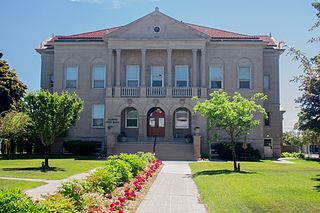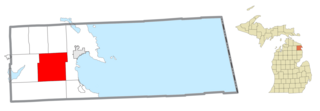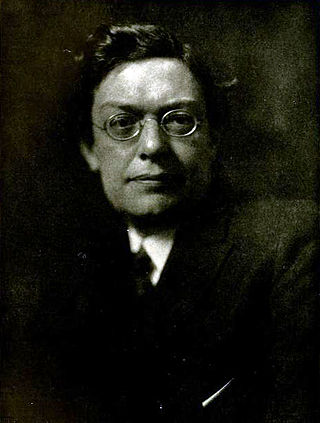
Presque Isle County is a county in the Lower Peninsula of the U.S. state of Michigan. As of the 2020 census, the population was 12,982. The county seat is Rogers City. The county was authorized by state legislative action on April 1, 1840, but the county government was not established until 1871. The government was reorganized in 1875.

Iosco County is a county in the U.S. state of Michigan; its eastern border is formed by Lake Huron. As of the 2020 census, its population was 25,237. Its seat of government is Tawas City.

Alpena County is a county in the U.S. state of Michigan. As of the 2020 census, the population was 28,907. The county seat is Alpena. It is considered to be part of Northern Michigan.

Alcona County is a county of the U.S. state of Michigan. As of the 2020 census, the population was 10,167. Its county seat is Harrisville. Alphabetically it is the first county in Michigan; as its flag states, it is the "First of 83".

Waverly is a city in Bremer County, Iowa, United States. The population was 10,394 at the time of the 2020 census. It is the county seat of Bremer County and is part of the Waterloo–Cedar Falls Metropolitan Statistical Area.

Lincoln is a village in Alcona County in the U.S. state of Michigan. The population was 305 at the 2020 census.

Alpena is a city in the U.S. state of Michigan. It is the county seat of Alpena County, and is the only city within the county. The population was 10,197 at the 2020 census, making it the third most populated city in the Northern Michigan region, after Traverse City and Cadillac. The city is surrounded by Alpena Township, but the two are administered autonomously. It is the core city of the Alpena micropolitan statistical area, which encompasses all of Alpena County and had a total population of 28,907 at the 2020 census.

Long Rapids Township is a civil township of Alpena County in the U.S. state of Michigan. The population was 977 at the 2020 census.

Ossineke Township is a civil township of Alpena County in the U.S. state of Michigan. The population was 1,635 at the 2020 census.

Wilson Township is a civil township of Alpena County in the U.S. state of Michigan. The population was 1,972 at the 2020 census.

Rogers City is a city in the U.S. state of Michigan. It is the county seat of and largest city in Presque Isle County. The city had a population of 2,850 at the 2020 census, a slight increase from 2,827 at the 2010 census.

Redford Township is a charter township in Wayne County in the U.S. state of Michigan. An inner-ring suburb of Detroit, Redford borders Detroit to the west, roughly 15 miles (24.1 km) northwest of downtown Detroit. As of the 2020 census, the township had a population of 49,504.

Livonia is a city in Wayne County, Michigan, United States. A western suburb of Detroit, Livonia is located roughly 20 miles (32.2 km) northwest of downtown Detroit. As of the 2020 census, the city had a population of 95,535. Originally organized as Livonia Township in 1835, it incorporated as a city in 1950.

Northville is a city in Wayne and Oakland counties in the U.S. state of Michigan. A western suburb of Detroit, Northville is located roughly 27 miles (43.5 km) northwest of downtown Detroit, and 17 miles (27.4 km) northeast of Ann Arbor. As of the 2020 census, the city had a population of 6,119. It is entirely surrounded by Northville Township to the south, and Novi to the north.

Dinosaur Gardens is a tourist attraction in Ossineke, Michigan, United States. Built on a 40-acre (160,000 m2) tract of drained swampland, visitors encounter several dozen home-made sculptures of dinosaurs, prehistoric birds, prehistoric mammals, and cavemen. The attraction was started by folk artist Paul N. Domke in 1935. There is also a gift shop and a dinosaur-themed miniature golf course on the premises.

Charles Robert Knight was an American wildlife and paleoartist best known for his detailed paintings of dinosaurs and other prehistoric animals. His works have been reproduced in many books and are currently on display at several major museums in the United States. One of his most famous works is a mural of Tyrannosaurus and Triceratops, which helped establish the two dinosaurs as "mortal enemies" in popular culture. Working at a time when many fossil discoveries were fragmentary and dinosaur anatomy was not well understood, many of his illustrations have later been shown to be incorrect representations. Nevertheless, he has been hailed as "one of the great popularizers of the prehistoric past".

Land of Giants and The Giant Claw, marketed together as Chased by Dinosaurs in the United States, are two special episodes of the nature documentary television series Walking with Dinosaurs. Created by Impossible Pictures and produced by the BBC Studios Science Unit, the Discovery Channel and ProSieben, The Giant Claw was first broadcast on 30 December 2002, followed by Land of Giants on 1 January 2003. The two episodes stars British wildlife presenter Nigel Marven as a "time-travelling zoologist", interacting with dinosaurs and other prehistoric creatures, a drastic change in presentation from preceding entries in the Walking with... franchise.

Diego Lasansky is an American artist whose focus is on printmaking, painting, and drawing. He lives in Iowa City, Iowa.
Events from the year 1901 in Michigan.

William (Bill) A. Swan was a self-taught American artist whom overcame childhood adversity and went on to design and build some of the most memorable larger-than-life Giant sculptures that became symbolic of roadside Americana in the mid 20th century.



















